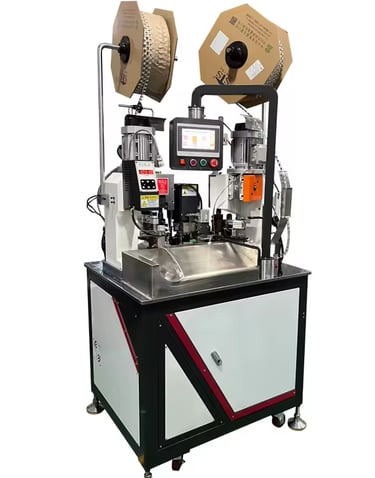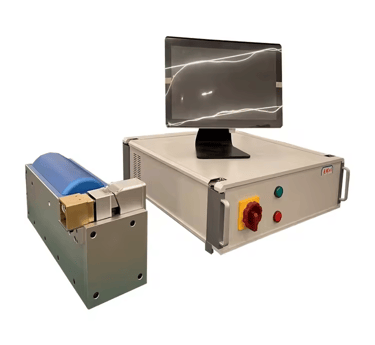Revolutionizing Industrial Efficiency: The Rise of Automated Cutting and Crimping Machines
LEON MACHINERY
1/3/20254 min read


The Evolution of Automation in Modern Industries
Automation has become a driving force behind the exponential growth of industrial efficiency. In today’s fast-paced manufacturing landscape, the ability to streamline operations, reduce manual intervention, and enhance precision is not just a luxury—it’s a necessity. Among the many innovations shaping this evolution, machines like automatic cable crimping machines, strip cutting machines, and tape wrapping machines are leading the charge. These cutting-edge technologies are not only revolutionizing industries but also setting new benchmarks in productivity and quality assurance.
Whether it’s cable processing, tubing management, or wire harness production, the need for automated solutions has never been more urgent. As industries grow, so does the demand for machines that can handle intricate tasks with remarkable speed and accuracy.
What is an Automatic Cable Crimping Machine and Why Does It Matter?
Automatic cable crimping machines are essential tools in the wire harness and cable assembly industry. These machines are designed to automate the process of attaching connectors to the ends of cables, ensuring a firm and secure connection.
Imagine a traditional method where each cable is manually crimped. It’s time-consuming, labor-intensive, and prone to errors. Enter the automatic cable crimping machine, which effortlessly handles hundreds—or even thousands—of crimps in a fraction of the time. Not only does this save time, but it also ensures uniformity and precision, two critical factors in maintaining the quality of the final product.
Key benefits include:
Increased production speed.
Enhanced consistency in crimp quality.
Reduction in labor costs.
Higher reliability for critical applications like automotive and telecommunications.
The Versatility of an Automatic Strip Cutting Machine
In industries dealing with wires, tubes, and other materials, an automatic strip cutting machine is a game-changer. These machines are engineered to cut a wide variety of materials—ranging from plastic to metal wires—into specific lengths with pinpoint accuracy.
What makes these machines indispensable is their adaptability. Whether you’re in electronics, textiles, or automotive manufacturing, strip cutting machines cater to diverse needs. For instance:
Precision Cutting: The machine ensures exact lengths every time, eliminating material wastage.
Wide Material Compatibility: From soft tubing to hard wires, these machines handle it all.
Ease of Use: Operators can program the machine to achieve desired lengths, saving time and effort.
Exploring the Functionality of an Automatic Tube Cutting Machine
While the strip cutting machine focuses on wires, the automatic tube cutting machine specializes in tubing. Industries such as medical devices, HVAC, and hydraulics rely on tubing for critical operations.
Consider the production of heat-shrink tubing, which is widely used for electrical insulation. Cutting these tubes manually can lead to uneven edges, inconsistent lengths, and slower production speeds. An automatic tube cutting machine eliminates these issues, offering:
Seamless processing of materials like PVC, rubber, or steel tubes.
Adjustable cutting lengths for custom applications.
Reduced operational downtime.
Wire Harness Accessories: The Backbone of Modern Electronics
Wire harnesses play a pivotal role in connecting electrical systems. But without the right accessories, even the most sophisticated harness is incomplete. Wire harness accessories like clips, connectors, and cable ties ensure that these assemblies are functional, durable, and easy to install.
For industries like automotive, aerospace, and consumer electronics, choosing the right accessories is crucial. They not only improve the reliability of the harness but also simplify maintenance and repairs.
How Automatic Feeding Machines Enhance Productivity
Imagine a factory floor where workers manually feed components into machines—a tedious and inefficient process. Automatic feeding machines transform this scenario by automating the feeding of materials into production lines.
Applications of automatic feeding machines span across industries, from pharmaceuticals to electronics. They can handle:
Precise dispensing of components into assembly lines.
High-speed feeding for increased production rates.
Versatility in handling different materials like pills, screws, or wires.
The Role of an Automatic Tape Wrapping Machine in Wire Assembly
Automatic tape wrapping machines are essential for bundling wires and cables. These machines ensure that the wires are neatly wrapped with insulating or protective tape, improving both functionality and aesthetics.
Manual wrapping not only takes time but also results in inconsistent outcomes. By automating the process, these machines deliver:
Uniform wrapping for better protection.
Faster production cycles.
Reduced operator fatigue.
Multi-Function Cutting Machines: One Tool, Endless Possibilities
For manufacturers seeking versatility, multi-function cutting machines are the ultimate solution. These machines combine multiple cutting capabilities into a single system, allowing businesses to handle diverse materials and tasks with ease.
Applications include:
Cutting wires, tubes, and tapes in one setup.
Handling materials of varying thickness and flexibility.
Reducing the need for multiple machines, thereby saving space and costs.
Heat Shrink Tubing Machines: A Critical Asset for Electrical Insulation
Heat shrink tubing is a staple in electrical and electronic applications, providing insulation and protection. Heat shrink tubing machines automate the process of cutting and shrinking tubes to fit over wires or connectors.
Industries like automotive, aerospace, and telecommunications rely on these machines to:
Achieve precise cuts for custom applications.
Ensure consistent shrinkage for secure insulation.
Streamline production for large-scale operations.
Why Test Machines Are Non-Negotiable in Quality Assurance
No matter how advanced a production line is, quality testing remains a cornerstone of manufacturing. Test machines play a critical role in ensuring that products meet stringent standards before reaching the market.
These machines are used to:
Verify the durability of wire harnesses.
Test the strength of crimped cables.
Ensure that cut materials meet specified dimensions.
Automatic Labeling Machines: Precision Meets Branding
Labeling is an integral part of manufacturing, especially for industries that require detailed product information or branding. Automatic labeling machines take this task to the next level by offering:
High-speed labeling for mass production.
Accurate placement of labels on products.
Customizable options for different label sizes and materials.
The Future of Automation in Manufacturing
The rapid advancement of automation technologies indicates a bright future for industries worldwide. Machines like automatic cable crimping machines and multi-function cutting machines are just the beginning. As technology evolves, we can expect even smarter, faster, and more efficient solutions to emerge.
Automation isn’t just about replacing manual labor; it’s about enhancing human capabilities. By taking over repetitive and complex tasks, these machines allow workers to focus on innovation and problem-solving.
Conclusion: Embracing the Revolution
The rise of automated machines is transforming industries, enabling businesses to achieve unprecedented levels of efficiency and precision. Whether it’s an automatic strip cutting machine or a heat shrink tubing machine, each innovation brings us closer to a future where quality and productivity go hand in hand.
For businesses looking to stay ahead of the curve, embracing automation isn’t just an option—it’s a necessity. Explore these technologies today and take the first step toward revolutionizing your manufacturing processes.


